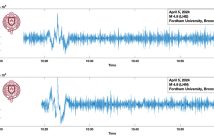While in high school, a young woman now enrolled in Ellen Silber�s Women�s Studies class at Marymount told her adviser she was interested in taking an advanced math class. �Dear,� the adviser said, �you don�t want to struggle.�
This may seem like a scene from another era, but even today, girls are sometimes discouraged from studying and pursuing careers in science.
�These subjects are coded �male,� and some girls are guided against their own interests by teachers and counselors,� said Ellen Silber, director of the Institute for the Education of Women and Girls at Marymount, who convened more than a dozen prominent educators for a Dec. 3 conference to explore ways to combat the problem. More than 80 educators and students attended the daylong �Righting the Angle� conference in the Library Lecture Hall on the Marymount campus.
The gender gap in science and math class enrollment for K-12 boys and girls has narrowed according to a 1998 study by the American Association of University Women. But it still exists, according to the study, and is particularly wide in physics and computer science. The result of these disparities is reflected in women in the science workforce: A 1998 study found that just 12 percent of physicists and 9 percent of engineers are female.
�Customizing [the curricula]is crucial to gender equity,� said Marcia Linn, Ph.D., professor of education in mathematics, science and technology at the University of California, Berkeley, during the keynote panel presentation.
Linn and a team from U.C. Berkeley have developed several interactive, multimedia programs that allow students to investigate contemporary scientific issues such as local water quality or genetically modified foods using computers and the Web. Teachers, though, need to �pick topics that are important to women, that bring women into science,� she said. �The goal,� said Linn, �is to make science personally relevant.�
Recruiting and retaining female science and technology faculty can also help inspire more girls to pursue careers in science, according to panelist Sue V. Rosser, dean of Ivan Allen College at the Georgia Institute of Technology. She cited a National Organization of Women Study that found that in 2003 just 3 to 15 percent of full professors in the nation�s top-50 engineering and science university research departments were women.
To attract more women to science faculties, Rosser said tenure must no longer be structured around the �life cycle of the white male.� Institutional policy changes are needed, she said, to help women on science faculties balance career and family, which female faculty members cite as their number one challenge.


